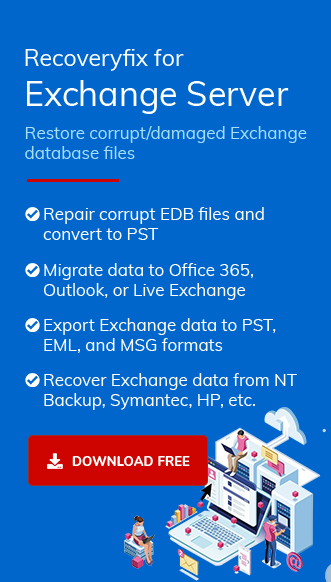Exchange Server EDB file is built up of pages of 4KB size, organized in a B-tree structure linked sequentially. The starting two pages make the header while the third one is considered as the first logical page. Conventionally, when an EDB file is written to the disk, checksum value of these pages are calculated and stored the header page. When any operation like Exchange database backup or other operation is performed, this checksum value is calculated and tallied with the actual one on the header. If there is any difference or mismatch between the values due to any reason, the process gets failed and the page is considered corrupted.
The reasons for this checksum values’ mismatch could be NTFS file system error, incorrect hard drive location for writing EDB file, etc. The Exchange error 1018 is due to corruption in the Exchange database (EDB) file. It is a page-level (physical) corruption and leads to the inaccessibility of EDB data. Usually, this error occurs when a user takes an online backup of the Exchange database. The error reads like this.
Exchange jet error 1018: Operation terminated >
Error 1018 jet_errreadverifyfailure checksum error >
Common causes for Getting the Exchange Error 1018
- Writing checksum in the wrong location.
- The data saved in EDB files could be corrupted.
- The checksum value that was computed can be incorrect.
- NTFS file system error.
- The mismatch between the current checksum value and the previous one.
Now, we’ll follow different methods for resolution for Exchange error 1018.
For this EDB page level corruption, we can try on some manual solutions provided by the Exchange Server, like in-built utility ESEUTIL commands to repair the existing EDB file or secured online backups programs to retrieve the Exchange data from a backup file..
Here, are the solutions to resolve Exchange error 1018.
Exchange administrators can use ESEUTIL for Exchange Server repair. ESEUTIL is a command line utility available within \EXCHSRVR\BIN directory. It is advised to take a backup of the existing Exchange database to avoid any data loss during the operation of this utility.
Step 1. Firstly, dismount the Exchange database and launch the ESEUTIL tool.
Step 2. Run this command to repair the EDB file, i.e. to fix corruption within the file, remove the damaged pages and also create the new table structure.
ESEUTIL /p >
Step 3. It is possible that due to deletion of the damaged pages, some white space is created within the EDB database. So, run the defragmentation command to defrag the database.
ESEUTIL /d >
Step 4. By running the above ESEUTIL commands, the database index and thus, logical & physical numbering of the EDB pages may get distorted which we can correct a using the ISINTEG command utility.
Step 5. Find the ISENTEG utility at the same location C:\Program Files\Microsoft\Exchange Server\V15\Bin and launch it. Then execute this command.
ISINTEG –s servername –fix –test all tests >
Step 6. After running this command, mount the Exchange Server database and then check if the error is resolved while taking the online backup.
If you have a recent Exchange backup file with you and do not want to run the in-built application commands, then you can restore of Exchange database using that backup easily. It would allow you to access your database again. The best utility to perform Exchange database backup/restore is Windows Server Backup utility.
If none of the above solutions work in your favor, then the ultimate way to fix the EDB corruption is using a trustworthy third-party tool. The advanced Recoveryfix for Exchange Server tool repairs corrupted EDB files using its powerful algorithms. The tool fixes all the Exchange corruptions and errors, including this page-level error.
Main functions of this EDB recovery tool:
- Repairs highly corrupted EDB files.
- Restores selective data from offline EDB files.
- Recovers mailboxes, public folders, archived mailboxes, etc.
- Preview of EDB data before saving to the destination.
- Saves recovered EDB data to Live Exchange, PST file, Office 3656, and more destinations.
- Restores Exchange database files from backups.
- Offers automated and quick database recovery.
- Full support to all Exchange Server versions.
- Time and effort-saving solution for fixing EDB issues.
- The trial version is absolutely free of cost.
Conclusion
Microsoft Exchange is an email client that is used for communication between consumers and enterprises. It can be difficult for the users when they face error Exchange error 1018. In this blog, we have discussed some effective solutions, both manual and automated, to resolve Exchange error 1018. If the manual methods do not work for you, and fail to resolve Exchange error 1018, you can use the advanced Software Recoveryfix for Exchange Server to repair corrupted EDB files using its powerful algorithms.
Read Related Blog


